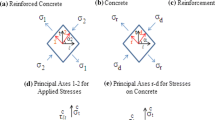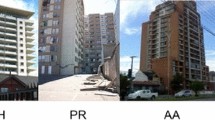Abstract
Poor performance of lightly reinforced and unconfined concrete structural walls have been observed in recent earthquake events. This research investigates the displacement capacity of such walls by comparing the results of a series of state-of-the-art finite element analyses for a range of different structural walls to that estimated using plastic hinge analyses. The common expressions used in estimating the yield curvature, yield displacement and plastic displacement are scrutinised for these types of walls. Some recommendations are given to improve the prediction of the displacement capacity of lightly reinforced and unconfined rectangular and C-shaped walls for flexural actions using a plastic hinge analysis. Importantly, a parameter has been recommended to be used in a “modified” approach for estimating the nominal yield displacement of lightly reinforced concrete walls. Different expressions are also recommended depending on the amount of longitudinal reinforcement used in the wall in comparison to that required to initiate secondary cracking. This is important for providing better estimations of the displacement capacity of RC structural wall buildings in low-to-moderate seismic regions such that vulnerability studies can be conducted.


























Similar content being viewed by others
References
ACI (2011) Building code requirements for structural concrete: (ACI 318-11); and commentary. American Concrete Institute, Farmington Hills
Adebar P, Lorzadeh A (2012) Compression failure of thin concrete walls. In: Paper presented at the 15 th world conference on earthquake engineering
Albidah A (2016) Vulnerability and risks of collapse of structural concrete walls in regions of low to moderate seismicity (Doctor of Philosophy). The University of Melbourne, Parkville
Albidah A, Altheeb A, Lam N, Wilson J (2013) A reconnaissance survey on shear wall characteristics in regions of low-to-moderate seismicity. In: Paper presented at the paper presented at the Australian Earthquake Engineering Society 2013 conference, Hobart, VIC
Almeida JP, Tarquini D, Beyer K (2016) Modelling approaches for inelastic behaviour of rc walls: multi-level assessment and dependability of results. Arch Comput Methods Eng 23(1):69–100
Altheeb A (2016) Seismic drift capacity of lightly reinforced concrete shear walls (Doctor of Philosophy). The University of Melbourne, Parkville
ASCE (2007) Seismic rehabilitation of existing buildings, vol 41. American Society of Civil Engineers Publications, Reston
Beca (2011) Investigation into the collapse of the Pyne Gould Corporation Building on 22nd February 2011, Report. 46 pp. Retrieved from http://www.mbie.govt.nz/publications-research/research/building-and-construction/quake-pyne-gould-corp-investigation-report.pdf
Belletti B, Damoni C, Gasperi A (2013) Modeling approaches suitable for pushover analyses of RC structural wall buildings. Eng Struct 57:327–338. https://doi.org/10.1016/j.engstruct.2013.09.023
Beyer K (2007) Seismic design of torsionally eccentric buildings with U-shaped RC walls. (PhD), ROSE School. (ROSE-2008/0X)
Beyer K, Dazio A, Priestley MJN (2008a) Inelastic wide-column models for U-shaped reinforced concrete walls. J Earthq Eng 12(sup1):1–33. https://doi.org/10.1080/13632460801922571
Beyer K, Dazio A, Priestley MJN (2008b) Quasi-static cyclic tests of two U-shaped reinforced concrete walls. J Earthq Eng 12(7):1023–1053. https://doi.org/10.1080/13632460802003272
Beyer K, Dazio A, Priestley MJN (2011) Shear deformations of slender reinforced concrete walls under seismic loading. ACI Struct J 108(2):167–177
Bohl A, Adebar P (2011) Plastic hinge lengths in high-rise concrete shear walls. ACI Struct J 108(2):148–157
Bradley BA, Quigley MC, Van Dissen RJ, Litchfield NJ (2014) Ground motion and seismic source aspects of the Canterbury earthquake sequence. Earthq Spectra 30(1):1–15
Brown A, Gibson G (2004) A multi-tiered earthquake hazard model for Australia. Tectonophysics 390(1–4):25–43
Cardenas AE, Magura DD (1972) Strength of high-rise shear walls—rectangular cross section. Spec Publ. https://doi.org/10.14359/17361
CERC (2012) Canterbury Earthquakes Royal Commission. Final report: volume 2. The performance of Christchurch CBD Buildings. Wellington, NZ
Constantin R (2016) Seismic behaviour and analysis of U-shaped RC walls. École polytechnique fédérale de Lausanne, Lausanne
Constantin R, Beyer K (2016) Behaviour of U-shaped RC walls under quasi-static cyclic diagonal loading. Eng Struct 106:36–52. https://doi.org/10.1016/j.engstruct.2015.10.018
Dai H (2011) An investigation of ductile design of slender concrete structural walls. (Master of Science), Iowa State University, Ames, Iowa
ElMohandes F (2013) Advanced three-dimensional nonlinear analysis of reinforced concrete structures subjected to fire and extreme loads (Doctor of Philosophy). University of Toronto, Toronto
ElMohandes F, Vecchio F (2013) Vector3 and FormWorks plus user manual. Department of Civil Engineering, University of Toronto. http://www.civ.utoronto.ca/vector/user_manuals/manual6.pdf. Accessed April 2017
FEMA (2010) HAZUS MH MR5 technical Manual. Washington, D.C
Fenwick R, Dhakal RP (2007) Material strain limits for seismic design of concrete structures. SESOC J NZ Struct Eng Soc 20(1):14–28
fib FIdB (2012) Model Code 2010—Final draft, volume 2. fib Bulletin No. 66. Lausanne, Switzerland
Ghorbani-Renani I, Velev N, Tremblay R, Palermo D, Massicotte B, Léger P (2009) Modeling and testing influence of scaling effects on inelastic response of shear walls. Struct J. https://doi.org/10.14359/56500
Goldsworthy HM (2012) Lessons on building design from the 22 February 2011 Christchurch earthquake. Aust J Struct Eng 13(2):159
Hannewald P (2013) Seismic behavior of poorly detailed RC bridge piers. (PhD thesis), EPFL. http://infoscience.epfl.ch/record/188364. Accessed April 2017
Henry RS (2013) Assessment of the minimum vertical reinforcement limits for RC walls. Bull N Z Soc Earthq Eng 46(2):88
Hines EM, Restrepo JI, Seible F (2004) Force-displacement characterization of well-confined bridge piers. Struct J. https://doi.org/10.14359/13340
Hoult R (2017) Seismic assessment of reinforced concrete walls in Australia. (PhD), University of Melbourne. http://hdl.handle.net/11343/192443. Accessed July 2017
Hoult R, Goldsworthy H, Lumantarna E (2017) Plastic hinge length for lightly reinforced rectangular concrete walls. J Earthq Eng. https://doi.org/10.1080/13632469.2017.1286619
Hoult R, Goldsworthy H, Lumantarna E (2018) Plastic hinge length for lightly reinforced C-shaped concrete walls. J Earthq Eng. https://doi.org/10.1080/13632469.2018.1453419
Ile N, Reynouard JM (2005) Behaviour of U-shaped walls subjected to uniaxial and biaxial cyclic lateral loading. J Earthq Eng 09(01):67–94
Kazaz l (2013) Analytical study on plastic hinge length of structural walls. J Struct Eng 139(11):1938
Krolicki J, Maffei J, Calvi GM (2011) Shear strength of reinforced concrete walls subjected to cyclic loading. J Earthq Eng 15(sup1):30–71. https://doi.org/10.1080/13632469.2011.562049
Kupfer HB, Gerstle KH (1973) Behavior of concrete under biaxial stresses. J Eng Mech Div 99(4):13
Lestuzzi P, Bachmann H (2007) Displacement ductility and energy assessment from shaking table tests on RC structural walls. Eng Struct 29(8):1708–1721. https://doi.org/10.1016/j.engstruct.2006.09.009
Lowes L, Lehman D, Kuchma D, Mock A, Behrouzi A (2013) Large-scale tests of C-shaped reinforced concrete walls from NEES Project warehouse. http://nees.org/warehouse/project/104. Accessed April 2017
Lu Y, Henry RS, Ma Q (2014) Modelling and experimental plan of reinforced concrete walls with minimum vertical reinforcement. In: Paper presented at the Tenth U.S. National conference on earthquake engineering, Anchorage, Alaska
Lu Y, Henry RS, Gultom R, Ma Q (2015) Experimental testing and modelling of reinforced concrete walls with minimum vertical reinforcement. In: Paper presented at the 2015 New Zealand Society for Earthquake Engineering annual technical conference, Rotorua, New Zealand
Luu H, Ghorbanirenani I, Léger P, Tremblay R (2013) Numerical modeling of slender reinforced concrete shear wall shaking table tests under high-frequency ground motions. J Earthq Eng 17(4):517–542. https://doi.org/10.1080/13632469.2013.767759
Maqsood T, Wehner M, Ryu H, Edwards M, Dale K, Miller V (2014) GAR15 Regional vulnerability functions record 2014/38: Geoscience Australia, Canberra
Menegon SJ, Tsang HH, Wilson JL (2015) Overstrength and ductility of limited ductile RC walls: from the design engineers perspective. In: Paper presented at the proceedings of the tenth pacific conference on earthquake engineering, Sydney, Australia
Menegon SJ, Wilson CJN, Lam NTK, Gad EF (2017) Experimental testing of reinforced concrete walls in regions of lower seismicity. Bull N Z Soc Earthq Eng 50(4):494–503
Moehle J (2015) Seismic design of reinforced concrete buildings. McGraw-Hill Education LLC, New York
Morris GJ, Bull DK, Bradley BA (2015) In situ conditions affecting the ductility capacity of lightly reinforced concrete wall structures in the canterbury earthquake sequence. Bull NZ Soc Earthq Eng 48(3):191–204
Oesterle RG, Fiorato AE, Johal LS, Carpenter JE, Russell HG, Corley WG (1976) Earthquake resistant structural walls - tests of isolated walls. Report to the National Science Foundation, Construction Technology Laboratories, Portland Cement Association, Skokie, Illinois, p 318
Oesterle RG, Aristizabal-Ochoa JD, Fiorato AE, Russel HE, Corley WG (1979) Earthquake resistant structural walls: tests of isolated walls: phase II. Construction Technology Laboratories, Portland Cement Association, Skokie
Park R (1989) Evaluation of ductility of structures and structural assemblages from laboratory testing. Bull NZ Soc Earthq Eng 22(3):155–166
Paulay T (1986) The design of reinforced concrete ductile shear walls for earthquake resistance. University of Canterbury, Department of Civil Engineering, Christchurch
Paulay T (2002) The displacement capacity of reinforced concrete coupled walls. Eng Struct 24(9):1165–1175. https://doi.org/10.1016/S0141-0296(02)00050-0
Pegon P, Plumier C, Pinto A, Molina J, Gonzalez P, Tognoli P, Hubert O (2000) U-shaped-wall: description of the experimental set-up TMR-ICONS-TOPIC5 (pp 23). JRC Ispra
Peña OAHdl (2001) Modelling and analysis of retrofitted reinforced concrete structures. (Master of Applied Science), University of Toronto. https://tspace.library.utoronto.ca/bitstream/1807/16282/1/MQ58767.pdf. Accessed April 2017
Priestley MJN, Kowalsky MJ (1998) Aspects of drift and ductility capacity of rectangular cantilever structural walls. Bull New Zealand Natl Soc Earthq Eng 31(2):73–85
Priestley MJN, Park R (1984) Strength and ductility of bridge substructures. RRU Bulletin 71, National Roads Board, Wellington
Priestley MJN, Seible F, Calvi GM (1996) Seismic design and retrofit of bridges. Wiley, New York
Priestley MJN, Calvi GM, Kowalsky MJ (2007) Displacement-based seismic design of structures. IUSS Press, Fondazione Eucentre, Pavia
RLB. (2014). Riders digest 2014 Adelaide, Australia Edition, Rider Levett Bucknall
Sittipunt C, Wood SL (1993) Finite element analysis of reinforced concrete shear walls. University of Illinois Engineering Experiment Station, College of Engineering, University of Illinois at Urbana-Champaign. Retrieved from http://hdl.handle.net/2142/14203
Smyrou E, Sullivan T, Priestley N, Calvi M (2013) Sectional response of T-shaped RC walls. Bull Earthq Eng 11(4):999–1019. https://doi.org/10.1007/s10518-012-9407-2
Sritharan S, Beyer K, Henry RS, Chai YH, Kowalsky M, Bull D (2014) Understanding poor seismic performance of concrete walls and design implications. Earthq Spectra 30(1):307–334. https://doi.org/10.1193/021713eqs036m
Standards Australia. (2009). AS 3600-2009: concrete structures
Standards Australia/New Zealand. (2001). AS/NZS 4671:2001: steel reinforcing materials
Sullivan TJ, Priestley MJN, Calvi GM (2012) A model code for the displacement-based seismic design of structures. IUSS Press, Pavia
Thomsen J, Wallace J (2004) Displacement-based design of slender reinforced concrete structural walls—experimental verification. J Struct Eng 130(4):618–630. https://doi.org/10.1061/(asce)0733-9445(2004)130:4(618)
Vecchio F (1992) Finite element modeling of concrete expansion and confinement. J Struct Eng 118(9):2390–2406
Vecchio F, Lai D, Shim W, Ng J (2000) Disturbed stress field model for reinforced concrete: validation. J Struct Eng 126(9):1070
Wallace JW, Moehle JP (1992) Ductility and detailing requirements of bearing wall buildings. J Struct Eng 118(6):1625–1644
Wibowo A, Wilson J, Lam NTK, Gad EF (2013) Seismic performance of lightly reinforced structural walls for design purposes. Mag Concr Res 65:809–828
Wibowo A, Wilson CJN, Lam N, Gad E (2016) Yield penetration displacement of lightly reinforced concrete columns. Appl Mech Mater 845:119–125
Wight JK, Jirsa, JO, Corley WG (1984) SP-084: earthquake effects on reinforced concrete structures: U.S.- Japan Research. Spec Publ. https://doi.org/10.14359/14041
Wong P, Vecchio F, Trommels H (2013) Vector2 and FormWorks user manual. Department of Civil Engineering, University of Toronto, Toronto
Wood SL (1989) Minimum tensile reinforcement requirements in walls. ACI Struct J 86(5):582–591
Wood S, Stark R, Greer S (1991) Collapse of eight-story RC building during 1985 Chile Earthquake. J Struct Eng 117(2):600–619
Zhang ZW, Li B (2014) Evaluation of seismic performance of slender L-shaped and T-shaped RC structural walls. In: Paper presented at the proceedings of the 2nd European conference on earthquake engineering and seismology
Acknowledgements
The support of the Commonwealth of Australia through the Cooperative Research Centre program is acknowledged.
Author information
Authors and Affiliations
Corresponding author
Rights and permissions
About this article
Cite this article
Hoult, R.D., Goldsworthy, H.M. & Lumantarna, E. Plastic hinge analysis for lightly reinforced and unconfined concrete structural walls. Bull Earthquake Eng 16, 4825–4860 (2018). https://doi.org/10.1007/s10518-018-0369-x
Received:
Accepted:
Published:
Issue Date:
DOI: https://doi.org/10.1007/s10518-018-0369-x




